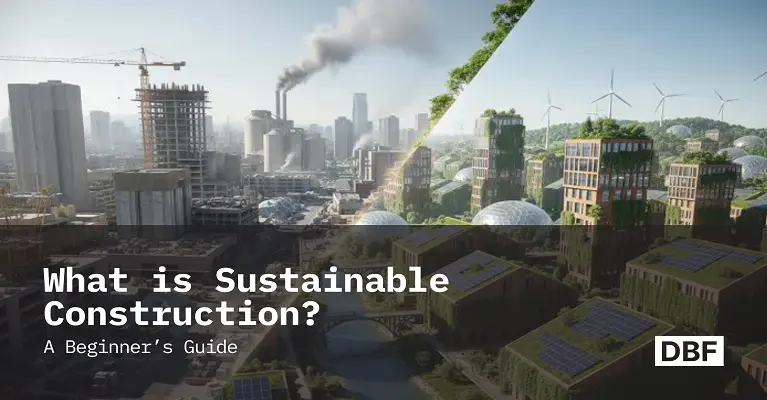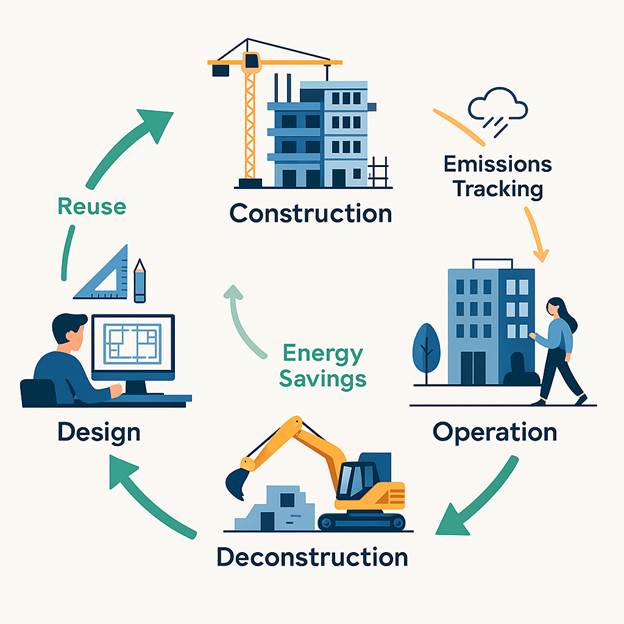
What is Sustainable Construction? A Beginner’s Guide for Architects and Urban Planners
Sustainable construction is reshaping how we design, build, and manage buildings for a greener future. This beginner-friendly guide explores eco-conscious principles like energy efficiency, waste reduction, material conservation, and lifecycle thinking. It highlights how sustainable methods—using recycled materials, renewable energy, and passive design—help reduce CO₂ emissions and environmental impact. The blog also explains how tools like BIM, GIS, and Digital Blue Foam’s AI-powered simulations enable architects and urban planners to embed sustainability from the earliest design stages. With strategic planning, green certifications, and collaborative technology, sustainable construction becomes both practical and essential for climate-resilient urban development.

The environmental effect of conventional building practices is a growing worry in light of the ever-increasing demand for construction materials and the exponential growth of urban areas.
Around 37% of the world's CO₂ emissions come from the construction industry, which is largely due to energy-intensive processes, non-renewable resources, and poor planning.
This is where eco-friendly construction methods truly excel. When infrastructure is planned, built, and operated in a way that reduces negative effects on society, the environment, and the economy over time, we consider it sustainable.
This method rethinks the whole building lifetime, from planning to demolition, by using renewable energy sources and environmentally friendly construction materials like bamboo and recycled steel.
Green construction goes beyond simply fulfilling certification standards like LEED or BREEAM, as anyone working in the fields of urban planning, design, politics, or development will confirm. Building climate-resilient, resource-efficient cities that contribute to global climate objectives is the ultimate objective.
Topics covered in this blog post include sustainable design, energy efficiency, waste reduction, and material selection, which are the fundamentals of green construction.
Also covered how modern software like BIM and GIS is playing a role in the movement toward more environmentally friendly building practices.
What is Sustainable Construction?
Designing, building, and managing buildings in a manner that minimizes environmental effects, conserves resources, and improves human well-being is known as sustainable construction. From initial site planning and material selection to energy use and final recycling, it incorporates environmental, financial, and social sustainability across the whole building lifetime.
Goals of Sustainable Construction
The main goal for sustainable construction is designing, building, and managing buildings in a manner that minimizes environmental effects, conserves resources, and improves human well-being. This includes initial site planning and material selection to energy use and final recycling. It incorporates environmental, financial, and social sustainability across the whole building lifetime.
Core Principles of Sustainable Construction
Sustainable Materials and Technologies

Planning for Sustainable Construction
1. Site Selection & Climate Responsiveness
Effective sustainable construction begins with strategic site selection informed by rigorous climate analysis. Choosing a site is not simply about availability. It’s about ecological viability and long-term resilience.
- Solar Orientation: Optimize building massing and positioning to maximize passive solar gain in colder climates and reduce heat exposure in warmer ones.
- Topography & Drainage: Assess site slope and floodplain exposure to mitigate water risk and reduce the need for excessive grading or stormwater engineering.
- Airflow & Urban Heat Island (UHI) Effect: Use wind rose data and local meteorological patterns to enhance natural ventilation and mitigate UHI impact through thoughtful material selection and vegetation integration.
- Microclimate Optimization: Leverage GIS data to identify shading, wind corridors, and sun paths for microclimate-responsive urban design.
2. Embedding Sustainability in Early Design Phases
Sustainability must be embedded at the conceptual design level, not retrofitted downstream. Early-phase planning decisions determine up to 80% of a building’s environmental impact.
- Set carbon, energy, water, and material benchmarks from the outset.
- Use iterative simulations to compare spatial configurations, facade designs, and land use allocations under varying environmental conditions.
- Prioritize low-impact development (LID) strategies: compact footprints, green infrastructure, and minimal hardscaping.
3. Digital Tools for Environmental Simulation
Advanced AI urban planning software like Digital Blue Foam (DBF) enable multidisciplinary teams to simulate environmental performance in real time bridging the gap between design intent and ecological reality.
- Daylight and Shadow Studies: Optimize access to daylight while minimizing glare and overheating.
- Carbon Modeling: Estimate embodied and operational carbon at the earliest stages to guide low-carbon material choices and energy strategies.
- Walkability & Accessibility Metrics: Map connections to amenities, transit, and public spaces to ensure inclusive and 15-minute city principles.
- Zoning Compliance & Massing Analysis: Rapidly test iterations to meet planning and zoning software requirements while enhancing livability and density.
4. Green Building Certifications & Performance Frameworks
Pursuing third-party certifications validates environmental performance and strengthens community trust.
- LEED (Leadership in Energy and Environmental Design) focuses on energy, water, materials, and indoor environmental quality.
- BREEAM (Building Research Establishment Environmental Assessment Method) emphasizes lifecycle performance and ecological footprint.
- WELL Building Standard centers on occupant health, comfort, and productivity.
- Local Green Codes align projects with city-level sustainability mandates and incentives (e.g., Singapore’s Green Mark, California’s CALGreen).
Integrating these frameworks not only bolsters a project's marketability but ensures measurable impact, making sustainable construction a tangible reality—not just a design philosophy.
Common Misconceptions Around Sustainable Construction
How Digital Blue Foam Supports Sustainable Construction Design
Conclusion
How we manage our planet's resources and the cities we construct now will shape how future generations view these issues. Sustainable construction approaches should be adopted for both professional and moral reasons.
In response to growing concerns about resource depletion, population growth, and the effects of climate change, sustainable construction practices are gaining prominence in the built environment.
Sustainable building practices are currently trending, and solar panels and recyclable materials are just one part of it. An all-encompassing approach is employed to lessen the environmental impact from inception to destruction by combining materials research, energy modeling, life cycle analysis, and design innovation.
Emerging technologies are reshaping our approach to sustainability in the building process.
AI-powered design simulations, planning based on geographic information systems, and building information modeling (BIM). Using these tools, professionals in the fields of architecture, engineering, and urban planning may evaluate and enhance built environments to maximize their ecological performance throughout time.
Frequently Asked Questions
- What does sustainable construction mean?
It refers to designing and building with minimal environmental impact while enhancing long-term economic and social outcomes.
- What are the main principles of sustainable construction?
Energy efficiency, low-carbon materials, lifecycle thinking, waste reduction, and occupant health.
- How can digital tools support sustainable construction?
They simulate performance (carbon, daylight, energy) early in design, enabling smarter, faster decisions.
- Is sustainable construction cost-effective?
Yes, it often delivers long-term savings in energy, maintenance, and resilience.


